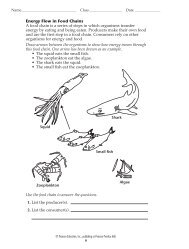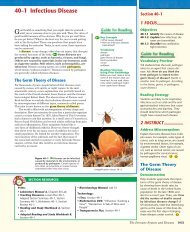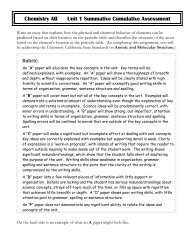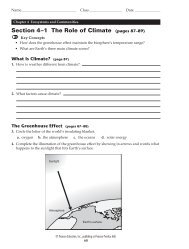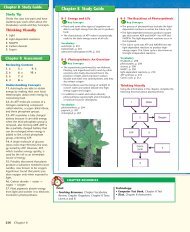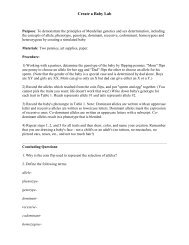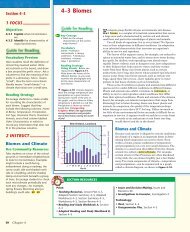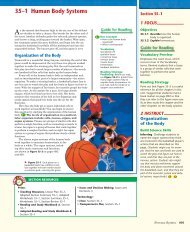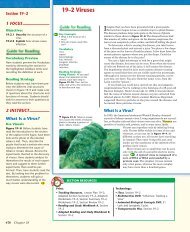ExamView - Quiz 6--Gravity, Circular motion, Torque.tst
ExamView - Quiz 6--Gravity, Circular motion, Torque.tst
ExamView - Quiz 6--Gravity, Circular motion, Torque.tst
Create successful ePaper yourself
Turn your PDF publications into a flip-book with our unique Google optimized e-Paper software.
Name: ________________________ Class: ___________________ Date: __________ID: A<strong>Quiz</strong> 6--Work, Gravitation, <strong>Circular</strong> Motion, <strong>Torque</strong>. (60 pts available, 50 points possible)Multiple Choice, 2 point eachIdentify the choice that best completes the statement or answers the question.1. What is the term for the net force directed toward the center of an object’s circular path?a. centrifugal force b. orbital force c. centripetal force d. circular force2. A car on a roller coaster loaded with passengers has a mass of 2.0 × 10 3 kg. At the lowest point of the track, the radius of curvature of thetrack is 24 m and the roller car has a tangential speed of 17 m/s. What centripetal force is exerted on the roller car at the lowest point?a. 2.4 × 10 1 N b. 2.4 × 10 4 N c. 2.4 × 10 3 N d. 2.4 × 10 2 N3. A horizontal force of 200 N is applied to move a 55 kg television set across a 10 m level surface. What is the work done by the 200 Nforce on the television set?a. 11000 J b. 550 J c. 2000 J d. 6000 J4. What is the common formula for work? Assume that W is the work, F is a constant force, ∆v is the change in velocity, and d is thedisplacement.a. W = Fd 2 b. W = F∆v c. W = Fd d. W = F 2 d5. A car on a roller coaster loaded with passengers has a mass of 2.0 × 10 3 kg. At the lowest point of the track, the radius of curvature of thetrack is 24 m and the roller car has a tangential speed of 17 m/s. What is the centripetal acceleration of the roller car at the lowest point onthe track?a. 10 m/s 2 b. 12 m/s 2 c. 11 m/s 2 d. 14 m/s 26. How much work is done on a bookshelf being pulled 5.00 m at an angle of 37.0° from the horizontal? The magnitude of the component ofthe force that does the work is 43.0 N.a. 20.5 J b. 21.5 J c. 205 J d. 215 J7. Which of the following energy forms is associated with an object in <strong>motion</strong>?a. kinetic energy b. nonmechanical energy c. potential energy d. elastic potential energy8. A professional skier starts from rest and reaches a speed of 56 m/s on a ski slope angled 30.0° above the horizontal. Using thework-kinetic energy theorem and disregarding friction, find the minimum distance along the slope the skier would have to travel in orderto reach this speed.a. 30 m b. 300 m c. 320 m d. 32 m9. A 35 kg child moves with uniform circular <strong>motion</strong> while riding a horse on a carousel. The horse is 3.2 m from the carousel’s axis ofrotation and has a tangential speed of 2.6 m/s. What is the child’s centripetal acceleration?a. 21 m/s^2 b. 0.21 m/s^2 c. 210 m/s^2 d. 2.1 m/s^210. If you want to open a swinging door with the least amount of force, where should you push on the door?a. in the middle b. as far from the hinges as possible c. close to the hinges d. It does not matter where you push.11. Which of the following quantities measures the ability of a force to rotate or accelerate an object around an axis?a. axis of rotation b. lever arm c. torque d. tangential force12. Which of the following can be a centripetal force?a. gravity b. tension c. friction d. all of the above13. The centripetal force on an object in circular <strong>motion</strong> isa. in the same direction as the centripetal acceleration. b. in the direction opposite the tangential speed. c. in the same direction asthe tangential speed. d. in the direction opposite the centripetal acceleration.14. A 61.5 kg student sits at a desk 1.25 m away from a 70.0 kg student. What is the magnitude of the gravitational force between the twostudents? (G = 6.673 × 10 −11 N•m 2 /kg 2 )a. 1.00 × 10 −7 N b. 1.84 × 10 7 N c. 1.84 × 10 −17 N d. 1.84 × 10 −7 N1
Name: ________________________ID: A15. A worker pushes a box with a horizontal force of 50.0 N over a level distance of 5.0 m. If a frictional force of 43 N acts on the box in adirection opposite to that of the worker, what net work is done on the box?a. 3.5 J b. 35 J c. 32 J d. 3.2 J16. A 35 kg child moves with uniform circular <strong>motion</strong> while riding a horse on a carousel. The horse is 3.2 m from the carousel’s axis ofrotation and has a tangential speed of 2.6 m/s. What is the centripetal force on the child?a. 74 N b. 740 N c. 0.74 N d. 7.4 NA child rides a bicycle in a circular path with a radius of 2.0 m. The tangential speed of the bicycle is 2.0 m/s. The combined mass of thebicycle and the child is 43 kg.17. What is the magnitude of the centripetal force on the bicycle?a. 86 N b. 43 N c. 4.0 N d. 3.7 kN18. What is the magnitude of the bicycle’s centripetal acceleration?a. 8.0 m/s 2 b. 2.0 m/s 2 c. 1.0 m/s 2 d. 4.0 m/s 219. What kind of force provides the centripetal force on the bicycle?a. normal force b. friction c. air resistance d. gravitational force20. Gravitational potential energy is always measured in relation toa. a zero level. b. kinetic energy. c. mechanical energy. d. total potential energy.21. When an object is moving with uniform circular <strong>motion</strong>, the centripetal acceleration of the objecta. is directed toward the center of <strong>motion</strong>. b. is zero. c. is perpendicular to the plane of <strong>motion</strong>. d. is circular.22. Which of the following is the rate at which work is done?a. power b. mechanical energy c. kinetic energy d. potential energy23. Which of the following equations expresses Newton’s law of universal gravitation?a. F c = mv t 2rb. F g = G m 1 m 2r 2 c. F g = m 1 m 2rd. g = G m Er 224. Work is done whena. the displacement is not zero. b. the force and displacement are perpendicular. c. the force is zero. d. the displacement is zero.25. When calculating the gravitational force between two extended bodies, you should measure the distancea. from the center of one body to the closest point on the other body. b. from the center of each body. c. from the most distant pointson each body. d. from the closest points on each body.26. A force does work on an object if a component of the forcea. parallel to the displacement of the object moves the object along a path that returns the object to its starting position.b. perpendicular to the displacement of the object moves the object along a path that returns the object to its starting position. c. isperpendicular to the displacement of the object. d. is parallel to the displacement of the object.27. Which of the following equations expresses the work-kinetic energy theorem?a. W net = ∆PE b. W net = ∆KE c. ∆W = ∆KE d. ME i = ME f28. A child moving at constant velocity carries a 2 N ice-cream cone 1 m across a level surface. What is the net work done on the ice-creamcone?a. 20 J b. 2 J c. 0.5 J d. 0 J29. What is the efficiency of a machine that requires 1.00 × 10 2 J of input energy to do 35 J of work?a. 35% b. 65% c. 29% d. 2.9%30. Which of the following energy forms is associated with an object due to its position?a. total energy b. positional energy c. potential energy d. kinetic energy2
ID: A<strong>Quiz</strong> 6--Work, Gravitation, <strong>Circular</strong> Motion, <strong>Torque</strong>. (60 pts available, 50 points possible)Answer SectionMULTIPLE CHOICE1. ANS: C PTS: 1 DIF: I OBJ: 7-1.22. ANS: B2.4 × 10 4 NGivenm = 2.0 × 10 3 kgv t = 17 m/sr = 24 mSolutionF c = mv t 2r=Ê2.0 × 10 3 ˆkgËÁ¯˜ ( 17 m/s ) 224 m= 2.4 × 10 4 NPTS: 13. ANS: CGivenF = 200 Nd = 10 mSolutionW = Fd = ( 200 N) ( 10 m) = 2 × 10 3 JPTS: 1 DIF: IIIA OBJ: 5-1.44. ANS: C PTS: 1 DIF: I OBJ: 5-1.25. ANS: B12 m/s 2Givenv t = 17 m/sr = 24 mSolutiona c = v t 2r=( 17 m/s ) 224 m= 12 m/s 2PTS: 11
ID: A6. ANS: D215 JGivenF = 43.0 Nd = 5.00 mSolutionW = Fd = ( 43.0 N) ( 5.00 m) = 215 JPTS: 17. ANS: A PTS: 1 DIF: I OBJ: 5-2.18. ANS: C320 mGivenv i = 0 m/sv f = 56 m/sθ = 30.0°g = 9.81 m/s 2SolutionW net = ∆KEW net = Fd = (mg sinθ)d∆KE = KE f − KE i = 1 2 mv f 2 − 0 = 1 2 mv f 2mgd sinθ = 1 2 mv f 2d =d =2v f2g sinθ( 56 m/s ) 2Ê( 2) 9.81 m/s 2 ˆ= 3.2 × 10 2 mËÁ¯˜ ( sin30.0° )PTS: 19. ANS: D2.1 m/s 2Givenv t = 2.6 m/sr = 3.2 mSolutiona c = v t 2r=( 2.6 m/s ) 23.2 m= 2.1 m/s 2PTS: 110. ANS: B PTS: 1 DIF: I OBJ: 7-4.111. ANS: C PTS: 1 DIF: I OBJ: 7-4.12
ID: A12. ANS: D PTS: 1 DIF: I OBJ: 7-1.213. ANS: A PTS: 1 DIF: I OBJ: 7-1.214. ANS: D PTS: 115. ANS: B35 JGivenF w = 50.0 NF k = −43 Nd = 5.0 mSolutionW net = F net d = ÊÈ˘ËÁ F w + F kˆ¯˜d =ÎÍ( 50.0 N) + ( −43 N)˚˙ ( 5.0 m)= 35 JPTS: 116. ANS: A74 NGivenm = 35 kgv t = 2.6 m/sr = 3.2 mSolutionF c = mv t 2rPTS: 117. ANS: AGivenm = 43 kgv t = 2.0 m/sr = 2.0 mSolutionF c = mv t 2r==ÊËÁ35 kg ˆ¯˜ ( 2.6 m/s ) 2= 74 N3.2 mÊËÁ 43 kg ˆ¯˜ ( 2.0 m/s ) 2= 86 N2.0 mPTS: 1 DIF: IIIA OBJ: 7-1.23
ID: A18. ANS: BGivenv t = 2.0 m/sr = 2.0 mSolutiona c = v t 2r=( 2.0 m/s ) 22.0 m= 2.0 m/s 2PTS: 1 DIF: IIIA OBJ: 7-1.119. ANS: B PTS: 1 DIF: II OBJ: 7-1.220. ANS: A PTS: 1 DIF: I OBJ: 5-2.521. ANS: A PTS: 1 DIF: I OBJ: 7-1.122. ANS: A PTS: 1 DIF: I OBJ: 5-4.123. ANS: B PTS: 1 DIF: I OBJ: 7-2.224. ANS: A PTS: 1 DIF: I OBJ: 5-1.225. ANS: B PTS: 1 DIF: I OBJ: 7-2.226. ANS: D PTS: 1 DIF: I OBJ: 5-1.227. ANS: B PTS: 1 DIF: I OBJ: 5-2.328. ANS: D PTS: 1 DIF: II OBJ: 5-1.429. ANS: AGivenW in = 1.00 × 10 2 JW out = 35 JSolutioneff = W outW in=35 J1.00 × 10 2 J= 0.35 = 35%PTS: 1 DIF: IIIA OBJ: 7-4.430. ANS: C PTS: 1 DIF: I OBJ: 5-2.14
RIDERSERIES - Relay modulesRCI-KITP with PUSH IN connection1 CO• 4000 VA switching capacity• Stable plug-in connections• LED (AC red / DC green) integrated in relay• Protective suppressor circuit for DC coil• Optional test button with latching function and inspection window• Identification of coils (AC red / DC blue)Industrial relay modules andsolid-state relays Technical dataOutputRated switching voltageMax. switching voltage, ACContinuous currentContact materialMechanical service lifeSparkover time / Drop-out timeRated dataStatus indicator [print] / Free-wheel diodeAmbient temperature (operational)Flammability class UL 94HumidityApprovalsInsulation coordination (EN 50 178)Rated voltageClearance and creepage distances for control side - load sideSurge voltage categoryPollution severity240 V AC400 V16 A (1AgNi 90/10AC coil 5 x 10 6 switch. ops, DC coil 10 x 10 6 switch. cycles8 ms / 6 msGreen LED = DC coil; red LED = AC coil / Yes-40 °C...+70 °CV-040 °C / 93 % rel. humidity, no condensationCE; GL250 V> 8 mmIII3BDimensionsClamping range (nominal / min. / max.)Length x width x heightNotemm²mmPUSH IN spring connection1.5 / 0.5 / 1.570 / 15.5 / 981) The relay connections 11 - 21, 12 - 22 and 14 - 24 must be bridgedwhen using the full continuous current (16 A).Ordering data24 V DC 1CO24 V AC 1CO115 V AC 1CO230 V AC 1COInputRated control voltageRated current ACRated current DCPower ratingAC Response/dropout VoltDC Response/dropout VoltCoil resistance24 V DC16.7 mA420 mW16.8 V / 2.4 V1440 Ω ±10 %24 V AC31.6 mA0.75 VA18 V / 3.6 V350 Ω ±10 %115 V AC7 mA0.8 VA86.3 V / 17.3 V8100 Ω ±15 %230 V AC3.5 mA0.8 VA172.5 V / 34.5 V32500 Ω ±15 %Ordering dataRelay with socketw. test button TypeOrder No.w.o. test buttonTypeOrder No.RCIKITP 24VDC 1CO LD/PB8897190000RCIKITP 24VDC 1CO LD8897110000RCIKITP 24VAC 1CO LD/PB8897200000RCIKITP 24VAC 1CO LD8897120000RCIKITP115VAC 1CO LD/PB8897210000RCIKITP 115VAC 1CO LD8897130000RCIKITP230VAC 1CO LD/PB8897220000RCIKITP 230VAC 1CO LD8897140000Ordering dataSpare relayTypeOrder No.w. test button w.o. test buttonRCI374AC4 RCI314AC48870250000 8870100000w. test button w.o. test buttonRCI374R24 RCI314R248870280000 8870130000w. test button w.o. test buttonRCI374S15 RCI314S158870290000 8870140000w. test button w.o. test buttonRCI374T30 RCI314T308870300000 8870150000Note1327250000 – 2012/2013B.7
Name: ________________________ID: B15. A force does work on an object if a component of the forcea. parallel to the displacement of the object moves the object along a path that returns the object to its starting position.b. perpendicular to the displacement of the object moves the object along a path that returns the object to its starting position. c. isparallel to the displacement of the object. d. is perpendicular to the displacement of the object.16. A worker pushes a box with a horizontal force of 50.0 N over a level distance of 5.0 m. If a frictional force of 43 N acts on the box in adirection opposite to that of the worker, what net work is done on the box?a. 3.5 J b. 3.2 J c. 32 J d. 35 J17. How much work is done on a bookshelf being pulled 5.00 m at an angle of 37.0° from the horizontal? The magnitude of the component ofthe force that does the work is 43.0 N.a. 215 J b. 21.5 J c. 205 J d. 20.5 J18. Which of the following quantities measures the ability of a force to rotate or accelerate an object around an axis?a. tangential force b. lever arm c. torque d. axis of rotation19. A professional skier starts from rest and reaches a speed of 56 m/s on a ski slope angled 30.0° above the horizontal. Using thework-kinetic energy theorem and disregarding friction, find the minimum distance along the slope the skier would have to travel in orderto reach this speed.a. 300 m b. 30 m c. 320 m d. 32 m20. Work is done whena. the displacement is zero. b. the displacement is not zero. c. the force and displacement are perpendicular. d. the force is zero.21. If you want to open a swinging door with the least amount of force, where should you push on the door?a. in the middle b. It does not matter where you push. c. close to the hinges d. as far from the hinges as possible22. A car on a roller coaster loaded with passengers has a mass of 2.0 × 10 3 kg. At the lowest point of the track, the radius of curvature of thetrack is 24 m and the roller car has a tangential speed of 17 m/s. What is the centripetal acceleration of the roller car at the lowest point onthe track?a. 10 m/s 2 b. 11 m/s 2 c. 12 m/s 2 d. 14 m/s 223. A child moving at constant velocity carries a 2 N ice-cream cone 1 m across a level surface. What is the net work done on the ice-creamcone?a. 0 J b. 20 J c. 0.5 J d. 2 J24. Which of the following can be a centripetal force?a. tension b. friction c. gravity d. all of the above25. Which of the following equations expresses the work-kinetic energy theorem?a. W net = ∆KE b. W net = ∆PE c. ∆W = ∆KE d. ME i = ME f26. What is the efficiency of a machine that requires 1.00 × 10 2 J of input energy to do 35 J of work?a. 29% b. 35% c. 65% d. 2.9%27. A 35 kg child moves with uniform circular <strong>motion</strong> while riding a horse on a carousel. The horse is 3.2 m from the carousel’s axis ofrotation and has a tangential speed of 2.6 m/s. What is the child’s centripetal acceleration?a. 21 m/s^2 b. 210 m/s^2 c. 0.21 m/s^2 d. 2.1 m/s^228. Which of the following energy forms is associated with an object due to its position?a. kinetic energy b. positional energy c. potential energy d. total energy29. A car on a roller coaster loaded with passengers has a mass of 2.0 × 10 3 kg. At the lowest point of the track, the radius of curvature of thetrack is 24 m and the roller car has a tangential speed of 17 m/s. What centripetal force is exerted on the roller car at the lowest point?a. 2.4 × 10 1 N b. 2.4 × 10 3 N c. 2.4 × 10 4 N d. 2.4 × 10 2 N30. Which of the following energy forms is associated with an object in <strong>motion</strong>?a. elastic potential energy b. potential energy c. nonmechanical energy d. kinetic energy2
ID: B<strong>Quiz</strong> 6--Work, Gravitation, <strong>Circular</strong> Motion, <strong>Torque</strong>. (60 pts available, 50 points possible)Answer SectionMULTIPLE CHOICE1. ANS: C PTS: 1 DIF: I OBJ: 7-2.22. ANS: D74 NGivenm = 35 kgv t = 2.6 m/sr = 3.2 mSolutionF c = mv t 2r=ÊËÁ 35 kg ˆ¯˜ ( 2.6 m/s ) 2= 74 N3.2 mPTS: 13. ANS: D PTS: 1 DIF: I OBJ: 5-1.24. ANS: AGivenv t = 2.0 m/sr = 2.0 mSolutiona c = v t 2r=( 2.0 m/s ) 22.0 m= 2.0 m/s 2PTS: 1 DIF: IIIA OBJ: 7-1.15. ANS: B PTS: 1 DIF: II OBJ: 7-1.26. ANS: AGivenm = 43 kgv t = 2.0 m/sr = 2.0 mSolutionF c = mv t 2r=ÊËÁ 43 kg ˆ¯˜ ( 2.0 m/s ) 2= 86 N2.0 mPTS: 1 DIF: IIIA OBJ: 7-1.27. ANS: B PTS: 1 DIF: I OBJ: 7-2.21
ID: B8. ANS: DGivenF = 200 Nd = 10 mSolutionW = Fd = ( 200 N) ( 10 m) = 2 × 10 3 JPTS: 1 DIF: IIIA OBJ: 5-1.49. ANS: C PTS: 1 DIF: I OBJ: 5-2.510. ANS: D PTS: 1 DIF: I OBJ: 5-4.111. ANS: C PTS: 1 DIF: I OBJ: 7-1.212. ANS: A PTS: 1 DIF: I OBJ: 7-1.113. ANS: A PTS: 114. ANS: D PTS: 1 DIF: I OBJ: 7-1.215. ANS: C PTS: 1 DIF: I OBJ: 5-1.216. ANS: D35 JGivenF w = 50.0 NF k = −43 Nd = 5.0 mSolutionW net = F net d = ÊÈ˘ËÁ F w + F kˆ¯˜d =ÎÍ( 50.0 N) + ( −43 N)˚˙ ( 5.0 m)= 35 JPTS: 117. ANS: A215 JGivenF = 43.0 Nd = 5.00 mSolutionW = Fd = ( 43.0 N) ( 5.00 m) = 215 JPTS: 118. ANS: C PTS: 1 DIF: I OBJ: 7-4.12
ID: B19. ANS: C320 mGivenv i = 0 m/sv f = 56 m/sθ = 30.0°g = 9.81 m/s 2SolutionW net = ∆KEW net = Fd = (mg sinθ)d∆KE = KE f − KE i = 1 2 mv f 2 − 0 = 1 2 mv f 2mgd sinθ = 1 2 mv f 2d =d =2v f2g sinθ( 56 m/s ) 2Ê( 2) 9.81 m/s 2 ˆ= 3.2 × 10 2 mËÁ¯˜ ( sin30.0° )PTS: 120. ANS: B PTS: 1 DIF: I OBJ: 5-1.221. ANS: D PTS: 1 DIF: I OBJ: 7-4.122. ANS: C12 m/s 2Givenv t = 17 m/sr = 24 mSolutiona c = v t 2r=( 17 m/s ) 224 m= 12 m/s 2PTS: 123. ANS: A PTS: 1 DIF: II OBJ: 5-1.424. ANS: D PTS: 1 DIF: I OBJ: 7-1.225. ANS: A PTS: 1 DIF: I OBJ: 5-2.33
ID: B26. ANS: BGivenW in = 1.00 × 10 2 JW out = 35 JSolutioneff = W outW in=35 J1.00 × 10 2 J= 0.35 = 35%PTS: 1 DIF: IIIA OBJ: 7-4.427. ANS: D2.1 m/s 2Givenv t = 2.6 m/sr = 3.2 mSolutiona c = v t 2r=( 2.6 m/s ) 23.2 m= 2.1 m/s 2PTS: 128. ANS: C PTS: 1 DIF: I OBJ: 5-2.129. ANS: C2.4 × 10 4 NGivenm = 2.0 × 10 3 kgv t = 17 m/sr = 24 mSolutionF c = mv t 2r=Ê2.0 × 10 3 ˆkgËÁ¯˜ ( 17 m/s ) 224 m= 2.4 × 10 4 NPTS: 130. ANS: D PTS: 1 DIF: I OBJ: 5-2.14
<strong>Quiz</strong> 6--Work, Gravitation, <strong>Circular</strong> Motion, <strong>Torque</strong>. (60 pts available, 50 points possible) [Version Map]A BMC 1 14MC 2 29MC 3 8MC 4 3MC 5 22MC 6 17MC 7 30MC 8 19MC 9 27MC 10 21MC 11 18MC 12 24MC 13 11MC 14 13MC 15 16MC 16 2MC 17 6MC 18 4MC 19 5MC 20 9MC 21 12MC 22 10MC 23 7MC 24 20MC 25 1MC 26 15MC 27 25MC 28 23MC 29 26MC 30 281




